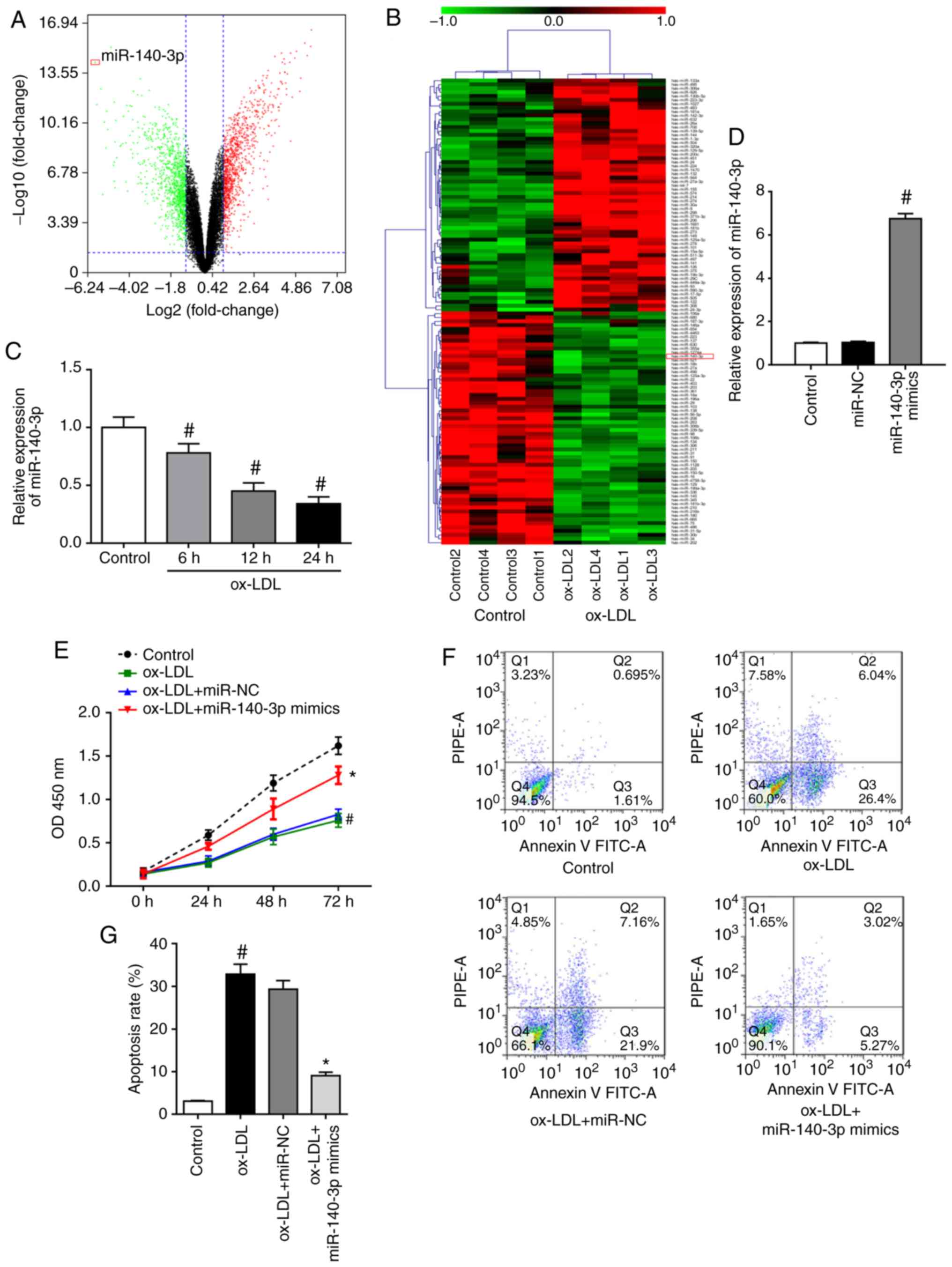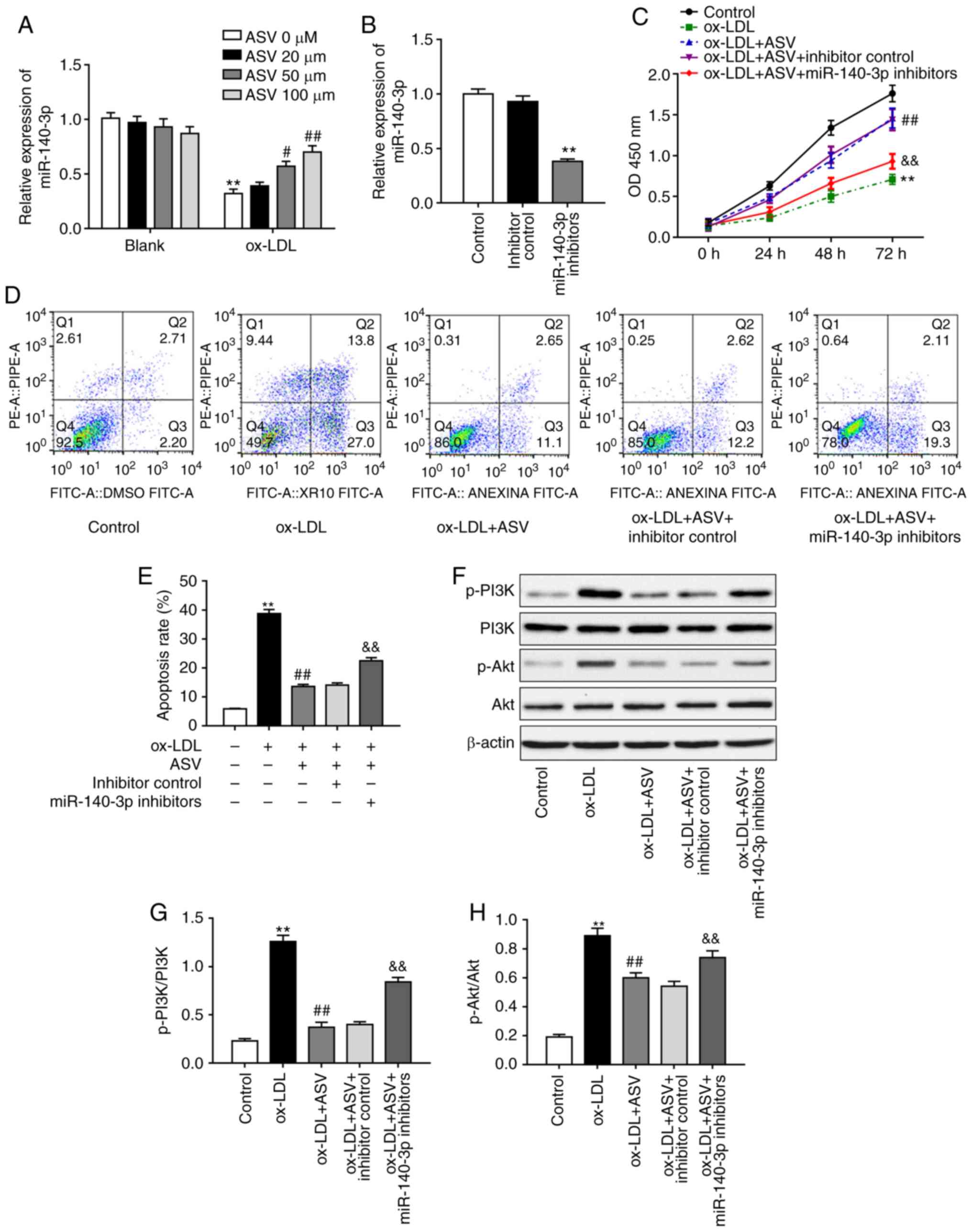|
1
|
Shore AC, Colhoun HM, Natali A, Palombo C,
Khan F, Östling G, Aizawa K, Kennbäck C, Casanova F, Persson M, et
al: Use of vascular assessments and novel biomarkers to predict
cardiovascular events in type 2 Diabetes: The SUMMIT VIP study.
Diabetes Care. 41:2212–2219. 2018. View Article : Google Scholar : PubMed/NCBI
|
|
2
|
Rao Kondapally Seshasai S, Kaptoge S,
Thompson A, Di Angelantonio E, Gao P, Sarwar N, Whincup PH, Mukamal
KJ, Gillum RF, Holme I, et al: Diabetes mellitus, fasting glucose,
and risk of cause-specific death. N Engl J Med. 364:829–841. 2011.
View Article : Google Scholar
|
|
3
|
Tousoulis D, Papageorgiou N, Androulakis
E, Siasos G, Latsios G, Tentolouris K and Stefanadis C: Diabetes
mellitus-associated vascular impairment: Novel circulating
biomarkers and therapeutic approaches. J Am Coll Cardiol.
62:667–676. 2013. View Article : Google Scholar : PubMed/NCBI
|
|
4
|
Shamsaldeen YA, Ugur R, Benham CD and
Lione LA: Diabetic dyslipidaemia is associated with alterations in
eNOS, caveolin-1, and endothelial dysfunction in streptozotocin
treated rats. Diabetes Metab Res Rev. 34:pp. e29952018, View Article : Google Scholar : PubMed/NCBI
|
|
5
|
Gilbert RE: Endothelial loss and repair in
the vascular complications of diabetes: Pathogenetic mechanisms and
therapeutic implications. Circ J. 77:849–856. 2013. View Article : Google Scholar : PubMed/NCBI
|
|
6
|
Fu C, Yin D, Nie H and Sun D:
Notoginsenoside R1 protects HUVEC against oxidized low-density
lipoprotein (Ox-LDL)-induced atherogenic response via
down-regulating miR-132. Cell Physiol Biochem. 51:1739–1750. 2018.
View Article : Google Scholar
|
|
7
|
Pollack RM, Donath MY, LeRoith D and
Leibowitz G: Anti-inflammatory agents in the treatment of Diabetes
and its vascular complications. Diabetes Care. 39(Suppl 2): pp.
S244–S252. 2016, View Article : Google Scholar : PubMed/NCBI
|
|
8
|
Song MT, Ruan J, Zhang RY, Deng J, Ma ZQ
and Ma SP: Astragaloside IV ameliorates neuroinflammation-induced
depressive-like behaviors in mice via the PPARγ/NF-κB/NLRP3
inflammasome axis. Acta Pharmacol Sin. 39:1559–1570. 2018.
View Article : Google Scholar : PubMed/NCBI
|
|
9
|
Liu ZH, Liu HB and Wang J: Astragaloside
IV protects against the pathological cardiac hypertrophy in mice.
Biomed Pharmacother. 97:1468–1478. 2018. View Article : Google Scholar : PubMed/NCBI
|
|
10
|
Li M, Li H, Fang F, Deng X and Ma S:
Astragaloside IV attenuates cognitive impairments induced by
transient cerebral ischemia and reperfusion in mice via
anti-inflammatory mechanisms. Neurosci Lett. 639:114–119. 2017.
View Article : Google Scholar
|
|
11
|
Qian W, Cai X, Qian Q, Zhang W and Wang D:
Astragaloside IV modulates TGF-β1-dependent epithelial-mesenchymal
transition in bleomycin-induced pulmonary fibrosis. J Cell Mol Med.
22:4354–4365. 2018. View Article : Google Scholar : PubMed/NCBI
|
|
12
|
Lin XP, Cui HJ, Yang AL, Luo JK and Tang
T: Astragaloside IV improves vasodilatation function by regulating
the PI3K/Akt/eNOS signaling pathway in rat aorta endothelial cells.
J Vasc Res. 55:169–176. 2018. View Article : Google Scholar : PubMed/NCBI
|
|
13
|
Leng B, Tang F, Lu M, Zhang Z, Wang H and
Zhang Y: Astragaloside IV improves vascular endothelial dysfunction
by inhibiting the TLR4/NF-κB signaling pathway. Life Sci.
209:111–121. 2018. View Article : Google Scholar : PubMed/NCBI
|
|
14
|
Stępień EŁ, Durak-Kozica M, Kamińska A,
Targosz-Korecka M, Libera M, Tylko G, Opalińska A, Kapusta M,
Solnica B, Georgescu A, et al: Circulating ectosomes: Determination
of angiogenic microRNAs in type 2 diabetes. Theranostics.
8:3874–3890. 2018. View Article : Google Scholar :
|
|
15
|
Liang W, Fan T, Liu L and Zhang L:
Knockdown of growth-arrest specific transcript 5 restores oxidized
low-density lipoprotein-induced impaired autophagy flux via
upregulating miR-26a in human endothelial cells. Eur J Pharmacol.
843:154–161. 2019. View Article : Google Scholar
|
|
16
|
Yin J, Hou X and Yang S: microRNA-338-3p
promotes ox-LDL-induced endothelial cell injury through targeting
BAMBI and activating TGF-β/Smad pathway. J Cell Physiol.
234:11577–11586. 2019. View Article : Google Scholar
|
|
17
|
Wang Y, Che J, Zhao H, Tang J and Shi G:
Paeoniflorin attenuates oxidized low-density lipoprotein-induced
apoptosis and adhesion molecule expression by autophagy enhancement
in human umbilical vein endothelial cells. J Cell Biochem.
120:9291–9299. 2019. View Article : Google Scholar
|
|
18
|
Yu S, Zhang L, Liu C, Yang J, Zhang J and
Huang L: PACS2 is required for ox-LDL-induced endothelial cell
apoptosis by regulating mitochondria-associated ER membrane
formation and mitochondrial Ca2+ elevation. Exp Cell
Res. 379:191–202. 2019. View Article : Google Scholar : PubMed/NCBI
|
|
19
|
Li B and Dewey CN: RSEM: Accurate
transcript quantification from RNA-Seq data with or without a
reference genome. BMC Bioinformatics. 12:3232011. View Article : Google Scholar : PubMed/NCBI
|
|
20
|
Livak KJ and Schmittgen TD: Analysis of
relative gene expression data using real-time quantitative PCR and
the 2(-Delta Delta C(T)) method. Methods. 25:402–408. 2001.
View Article : Google Scholar
|
|
21
|
You L, Fang Z, Shen G, Wang Q, He Y, Ye S,
Wang L, Hu M, Lin Y, Liu M and Jiang A: Astragaloside IV prevents
high glucose-induced cell apoptosis and inflammatory reactions
through inhibition of the JNK pathway in human umbilical vein
endothelial cells. Mol Med Rep. 19:1603–1612. 2019.PubMed/NCBI
|
|
22
|
Ma Y, Zhao Y, Zhang R, Liang X, Yin Z,
Geng Y, Shu G, Song X, Zou Y, Li L, et al: Astragaloside IV
inhibits PMA-induced EPCR shedding through MAPKs and PKC pathway.
Immunopharmacol Immunotoxicol. 39:148–156. 2017. View Article : Google Scholar : PubMed/NCBI
|
|
23
|
Xu C, Tang F, Lu M, Yang J, Han R, Mei M,
Hu J and Wang H: Pretreatment with Astragaloside IV protects human
umbilical vein endothelial cells from hydrogen peroxide induced
oxidative stress and cell dysfunction via inhibiting eNOS
uncoupling and NADPH oxidase-ROS-NF-κB pathway. Can J Physiol
Pharmacol. 94:1132–1140. 2016. View Article : Google Scholar : PubMed/NCBI
|
|
24
|
Lin H, Pan S, Meng L, Zhou C, Jiang C, Ji
Z, Chi J and Guo H: MicroRNA-384-mediated Herpud1 upregulation
promotes angiotensin II-induced endothelial cell apoptosis. Biochem
Biophys Res Commun. 488:453–460. 2017. View Article : Google Scholar : PubMed/NCBI
|
|
25
|
Wu CY, Zhou ZF, Wang B, Ke ZP, Ge ZC and
Zhang XJ: MicroRNA-328 ameliorates oxidized low-density
lipoprotein-induced endothelial cells injury through targeting
HMGB1 in atherosclerosis. J Cell Biochem. 2018.
|
|
26
|
Zhong X, Li P, Li J, He R, Cheng G and Li
Y: Downregulation of microRNA-34a inhibits oxidized low-density
lipoprotein-induced apoptosis and oxidative stress in human
umbilical vein endothelial cells. Int J Mol Med. 42:1134–1144.
2018.PubMed/NCBI
|
|
27
|
Li Y, Ye Y and Chen H: Astragaloside IV
inhibits cell migration and viability of hepatocellular carcinoma
cells via suppressing long noncoding RNA ATB. Biomed Pharmacother.
99:134–141. 2018. View Article : Google Scholar : PubMed/NCBI
|
|
28
|
Song Z, Wei D, Chen Y, Chen L, Bian Y,
Shen Y, Chen J and Pan Y: Association of astragaloside IV-inhibited
autophagy and mineralization in vascular smooth muscle cells with
lncRNA H19 and DUSP5-mediated ERK signaling. Toxicol Appl
Pharmacol. 364:45–54. 2019. View Article : Google Scholar
|
|
29
|
Wei DZ, Lin C, Huang YQ, Wu LP and Huang
MY: Ellagic acid promotes ventricular remodeling after acute
myocardial infarction by up-regulating miR-140-3p. Biomed
Pharmacother. 95:983–989. 2017. View Article : Google Scholar : PubMed/NCBI
|
|
30
|
Rasheed Z, Rasheed N and Al-Shaya O:
Epigallocatechin-3-O-gallate modulates global microRNA expression
in interleukin- 1β-stimulated human osteoarthritis chondrocytes:
Potential role of EGCG on negative co-regulation of microRNA-140-3p
and ADAMTS5. Eur J Nutr. 57:917–928. 2018. View Article : Google Scholar
|
|
31
|
Wei R, Liu H, Chen R, Sheng Y and Liu T:
Astragaloside IV combating liver cirrhosis through the
PI3K/Akt/mTOR signaling pathway. Exp Ther Med. 17:393–397.
2019.PubMed/NCBI
|
|
32
|
Tang F and Yang TL: MicroRNA-126
alleviates endothelial cells injury in atherosclerosis by restoring
autophagic flux via inhibiting of PI3K/Akt/mTOR pathway. Biochem
Biophys Res Commun. 495:1482–1489. 2018. View Article : Google Scholar
|
|
33
|
Yi J and Gao ZF: MicroRNA-9-5p promotes
angiogenesis but inhibits apoptosis and inflammation of high
glucose-induced injury in human umbilical vascular endothelial
cells by targeting CXCR4. Int J Biol Macromol. 130:1–9. 2019.
View Article : Google Scholar : PubMed/NCBI
|
|
34
|
Kawasaki Y, Fujiki M, Uchida S, Morishige
M, Momii Y and Ishii K: A single oral dose of Geranylgeranylacetone
upregulates vascular endothelial growth factor and protects against
Kainic acid-induced neuronal cell death: Involvement of the
Phosphatidylinositol-3 kinase/Akt pathway. Pathobiology.
84:184–191. 2017. View Article : Google Scholar : PubMed/NCBI
|
|
35
|
Giordano A, Romano S, D'Angelillo A,
Corcione N, Messina S, Avellino R, Biondi-Zoccai G, Ferraro P and
Romano MF: Tirofiban counteracts endothelial cell apoptosis through
the VEGF/VEGFR2/pAkt axis. Vasc Pharmacol. 80:67–74. 2016.
View Article : Google Scholar
|
|
36
|
Zhou Z, Rawnsley DR, Goddard LM, Pan W,
Cao XJ, Jakus Z, Zheng H, Yang J, Arthur JS, Whitehead KJ, et al:
The cerebral cavernous malformation pathway controls cardiac
development via regulation of endocardial MEKK3 signaling and KLF
expression. Dev Cell. 32:168–180. 2015. View Article : Google Scholar : PubMed/NCBI
|
|
37
|
Ohnesorge N, Viemann D, Schmidt N, Czymai
T, Spiering D, Schmolke M, Ludwig S, Roth J, Goebeler M and Schmidt
M: Erk5 activation elicits a vasoprotective endothelial phenotype
via induction of Kruppel-like factor 4 (KLF4). J Biol Chem.
285:26199–26210. 2010. View Article : Google Scholar : PubMed/NCBI
|
|
38
|
Choi H and Roh J: Role of Klf4 in the
regulation of apoptosis and cell cycle in rat granulosa cells
during the periovulatory period. Int J Mol Sci. 20:2018. View Article : Google Scholar
|
|
39
|
Wang J, Wang B, Chen LQ, Yang J, Gong ZQ,
Zhao XL, Zhang CQ and Du KL: miR-10b promotes invasion by targeting
KLF4 in osteosarcoma cells. Biomed Pharmacother. 84:947–953. 2016.
View Article : Google Scholar : PubMed/NCBI
|
|
40
|
Yang H, Xi X, Zhao B, Su Z and Wang Z:
KLF-4 protects brain microvascular endothelial cells from ischemic
stroke induced apoptosis by transcriptionally activating MALAT1.
Biochem Biophys Res Commun. 495:2376–2382. 2018. View Article : Google Scholar
|
|
41
|
Lv S, Ji L, Chen B, Liu S, Lei C, Liu X,
Qi X, Wang Y, Lai-Han Leung E, Wang H, et al: Histone
methyltransferase KMT2D sustains prostate carcinogenesis and
metastasis via epigenetically activating LIFR and KLF4. Oncogene.
37:1354–1368. 2018. View Article : Google Scholar :
|
|
42
|
Liu CH, Huang Q, Jin ZY, Zhu CL, Liu Z and
Wang C: miR-21 and KLF4 jointly augment epithelial-mesenchymal
transition via the Akt/ERK1/2 pathway. Int J Oncol. 50:1109–1115.
2017. View Article : Google Scholar : PubMed/NCBI
|













